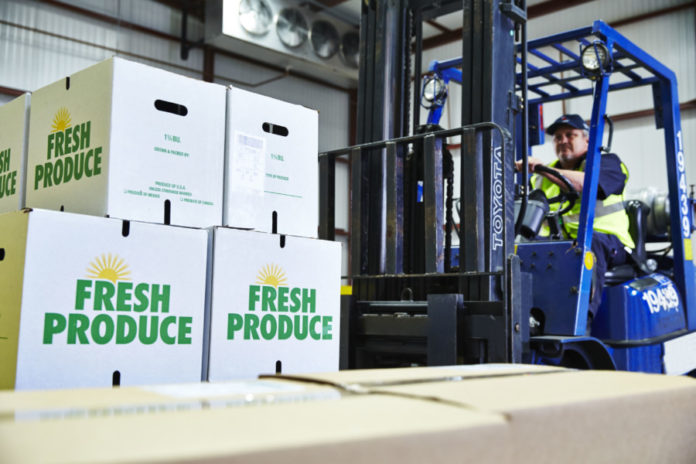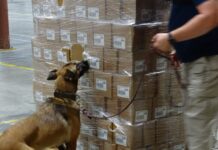

A major issue and demand in airfreight is for operators to provide customer visibility throughout the entire supply chain for perishables.
Panalpina’s regional business development manager for perishables, Quint Wilken says showing temperature deviation is vital in keeping product quality.
He notes: “Customers want to see what is changing in their supply chain at a day-to-day level to save themselves money and show their consumers that they are also targeting waste and protecting the environment.
“The biggest barrier to this though is airport handling where there is still a big gap in origin countries such as those in Latin America.”
As part of this improvement in airport perishables infrastructure, Panalpina is now operating two facilities at Amsterdam Airport Schiphol – one for healthcare products and the other to perishables and general cargo.
The perishables facility has been upgraded with new cold storage cells and ensuring everything from handling to customs clearance takes place under one roof to reduce transit times.
Edmonton International Airport has also increased its focus on perishables similarly highlighting a decline in oil and gas cargo as a key driver, and director of air service development Norm Richard says perishables is its strongest performing sector and it is focusing on improving capacity and flow-time.
Miami International Airport (MIA) is also making strides combining both air and ocean capabilities. In October, it announced plans to create an ocean to air perishables trans-shipment program, to allow the airport to receive freight imports by sea as well as by air.
Customised Brokers will co-ordinate the ocean shipment of perishables from Latin America to PortMiami or Port Everglades and transport them to MIA. They will then depart via KLM Cargo or Centurion Cargo to Europe and Asia. US Customs and Border Protection (CBP) has also granted approval for quicker processing.
Miami said it will strengthen the airport’s business adding to the 1.92 million tonnes of international airfreight already handled every year and ensure customers get Latin American produce at the “peak of freshness”.
Marketing director, Chris Mangos says the pilot program had been approved but “we are not there yet with announcing first shipments” – and is set to have more news in January.
MIA handles over 66 per cent of all perishable imports and almost 90 per cent of all flower imports into the US.
Mangos did raise concerns about the limited number of CBP and USDA inspectors assigned to the airport causing inspection delays.
So, what of the airlines?
Lufthansa Cargo has a special product for perishables called Fresh/td. It covers transport planning, ensuring temperature controlled environments during flight and storage, specially trained personnel and direct deliveries to customer doorsteps using refrigerated trucks.
Lufthansa Cargo’s head of operations Fresh/td, Oliver Blum sees development of perishables through its time:matters service. “It has established itself in recent years as the leading specialist for sameday delivery and emergency logistics in Europe. With taking full control we are aiming to grow our business in the special segment as well,” he says.
He adds: “Our focus is all about maximum reliability, exceptional service and customised solutions. We have already been co-operating for years and are looking forward to gaining further benefits for our customers.“
Etihad Cargo has an established presence in perishables but is eyeing up future growth opportunities. “Fresh has been a staple product for us with key routes including Africa to Europe out of Kenya and chilled meat moving out from Australia to Europe,” says senior vice president. David Kerr (pictured below).
“The UAE is a net importer of food so being able to get the products by air is an important driver for our business. Generally, consumers are looking for fresh products all the year around. It isn’t as seasonal as it used to be, the demand is constantly there.”
Developing markets are helping boost demand with Kerr highlighting China and India but also Vietnam. “It’s growing well above market rate. We are sending both passenger and freighter perishable loads into Hanoi,” Kerr says. “We move 50-50 when it comes to belly and freighter.”
Kerr acknowledges some products such as those “where part of the process is to leave them to ripen on a longer journey” are suited to ocean freight. But it can challenge in other areas where perishables have a shorter shelf life.
“Speed to market and to a customer’s door is critical as is getting quick clearance by food control regulators,” he states. “Getting the process right is fundamental by reducing dwell time and avoiding double-handling. It means planning where loads come in and out to reduce ramp time. Technology also plays its part with thermal blankets needed to keep temperature control, particularly in the heat of UAE.”
“It’s about maintaining the cool chain and adding another layer of risk avoidance. You have to keep competitive and responsive,” says Kerr. “Perishables need airfreight solutions because of growing trans-continental demand. It is about showing your competence and creating trust and having a clear dialogue with customers.”
















